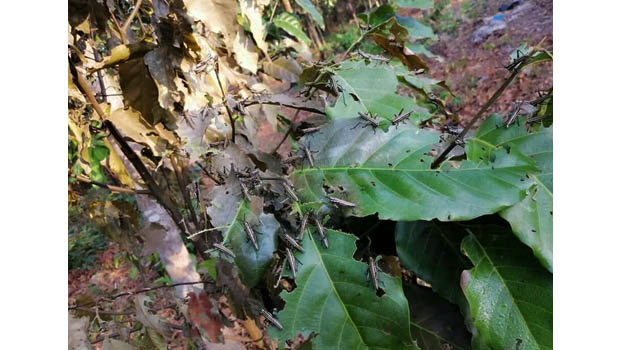Not locust, insect found in Teknaf

The insect seen in Teknaf of Cox's Bazar, is not a locust, it is a species of grasshopper informed the members of the investigation team formed by experts and scientists from the Ministry of Agriculture. Besides, they have claimed that such insects already exist in Bangladesh.
This insect has caused a stir in the media in the last few days. Panic spread among the farmers. The members of the investigation team coming from Dhaka informed this to the reporters after inspecting the vegetation and yard of the house where the 'unknown insect' was found in Lombari Para under Sadar Union of Teknaf Upazila on Saturday.
Four separate delegations comprising 10 experts and scientists from the Bangladesh Paddy Research Institute, Bangladesh Agricultural Research Institute, Bangabandhu Agricultural Research Center and the Department of Agricultural Extension jointly visited Teknaf's damaged settlement sent by the Ministry of Agriculture.
They jointly agreed after inspecting the damaged yard that the ‘unknown insects’ found in Teknaf were not locusts; It is a common species of grasshopper, a minor pest.
Bangladesh Rice Research Institute Principal and Scientific Officer Nazmul Bari said, “The insect seen in Teknaf was not a locust. It is a grasshopper, it is an insect of Bangladesh and it already exists. The insect lays eggs. The baby is born from the egg, the baby is called Neems. And Neems has appeared here.” Because many ‘neems’ stay together, many have mistakenly called these insects ‘locusts’, said Dr. Bari.
The scientific officer said, “When the insect grows big and grows wings, it will show small spots on its body. This is why the insect is also called 'spotted grasshopper. Besides, this insect has a defense mechanism. When it grows up and other insects try to eat or harm it, it releases a kind of poisonous foam through its mouth. Other insects or enemies cannot come near it because of the toxic foam. ”
The scientific name of the insect is ‘Aliarses Miliaris’ and it is an insect of the genus ‘Pygodapemi’ added Dr. Bari. Such insects already exist in Bangladesh, India, Myanmar, Thailand and Vietnam, as well as in Southeast Asian countries according to the scientists.
Commenting that it is possible to control such insects by spraying common pesticides or insecticides, the Deputy Director of Khamarbari under Department of Agricultural Extension in Dhaka Rezaul Karim said local agricultural officials were advised to spray common pesticides or pesticides if the upper echelons of the so-called unidentified insects were reported in Teknaf.
"It has been possible to suppress or prevent the spread of these insects by spraying Ciphermethrin pesticides. Not a single live insect was found after spraying for 2/3 consecutive days. No such insects were found in the vicinity of the damaged settlement”, he said.
Local agricultural officials have preserved live samples of some insects before spraying, said a senior scientific officer at the Rice Research Institute Panna Ali. He said the collected samples would be examined and researched to see if there was a possibility of a large-scale outbreak of such insects in Bangladesh. Since this type of insect causes some damage to crops, fruits and forest trees.
Later, based on the results of the research, it will be possible to take more effective measures to control, propagate and prevent the invasion of these grasshoppers.
Rahim, Faridul Alam and Golam Azam, farmers of Teknaf, said that they were in a state of panic due to various propaganda in the media about this insect. After today's announcements, their tension was relieved.
Deputy Commissioner of Cox's Bazar Md. Kamal Hossain said, "We were telling the locals not to panic in this regard from the very beginning."




